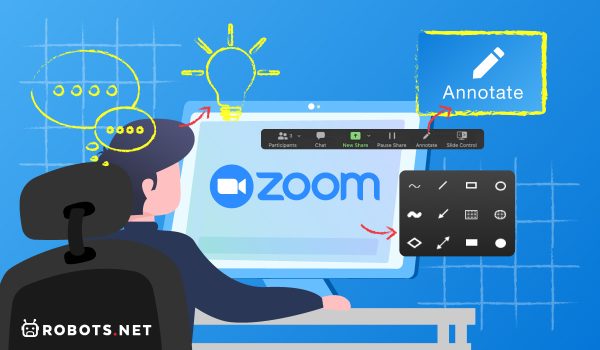What Does Annotation Mean?
An annotation is a small comment, note, or drawing that is placed next to a piece of text or presentation. Annotations normally provide additional information or context to a particular section of a presentation or text. For example, a student can write comments and questions about the different parts of a text on the sidelines of a textbook. Annotations provide viewers additional information on any information subject matter and help to provide context for much-needed discussion and decision-making. Naturally, annotations are just a small part of what meetings are all about. Meetings should be more about verbal communication than anything, and it’s all about being able to voice your thoughts and listen to what others have to say. In that case, you may need a reliable pair of noise-canceling headphones or wireless headphones to be able to hear and be heard clearly.
How Does Zoom’s Annotation Feature Work?
Zoom’ is a highly popular video conferencing platform, and it comes with its own set of annotation tools. However, these tools only become available when you use the Whiteboard feature or whenever you share your desktop/application screen. Once you’re on a whiteboard or sharing your screen through a desktop, many annotation tools will become available on your screen. Additionally, since most meeting controls lie with the host, so too are the controls for annotation. Of course, this is not to say that the tools are exclusively accessible to the host. Attendees can also access annotation tools, but they can only do so with proper permissions from the host. Additionally, we also need to note that the Whiteboard and desktop sharing features are only accessible via the desktop version of Zoom. In other words, you cannot annotate when you are presenting using the mobile version of the application.
How to Annotate Zoom Meetings for Productive Meetings
The ability to annotate text on the screen during Zoom meetings is very useful for situations when the topic is highly technical or entirely new to the audience. It’s also very useful when the topic requires a lot of discussion and decision-making. Having said this, you’re going to want to know how to pull up the annotation tools on Zoom, whether or not you are the assigned moderator or not. Here are the steps:
How to Enable/Disable Annotation for Other Participants
Earlier, we’ve mentioned that only the host can control permissions for the majority of in-meeting tools, including annotation. Giving other members the ability to annotate allows them to point out sections of the presentation they wish to discuss/clarify. In this way, it encourages participation and collaboration among the team members. Here is how you can go about letting other members in on the annotation toolkit:
How to Record and Annotate Meetings with Jumpshare
While Zoom has in-app controls for recording meetings, you can use a screen recorder software like Jumpshare to record and annotate a meeting in progress before sharing. That is, you can record a snippet of the meeting and add annotations via Jumpshare. As an alternative, you can turn to a webcam recording software to record your meeting, though you would have to annotate using Zoom. Afterward, you can already share the files via cloud or email to other people for virtual collaboration. Here is how you can go about exactly that:
How to Annotate on Zoom for Productive Meetings: Final Thoughts
The annotation marker is one of the more practical tools on Zoom. Or at least, next to the share screen and recording functions on the platform. Using annotations during meetings makes it easy for your audience to understand the information that you are trying to relay. It also helps you hold the attention of your easily-distracted audience from start to finish. It allows you to present creatively using visual and verbal cues to help get the message through. Surely, the combination of sharing, annotating, and recording your screen should be enough to add that human touch to all of your collaborative efforts online. If you want to explore your possibilities with other video streaming services, here is a list of the best Zoom alternatives.




